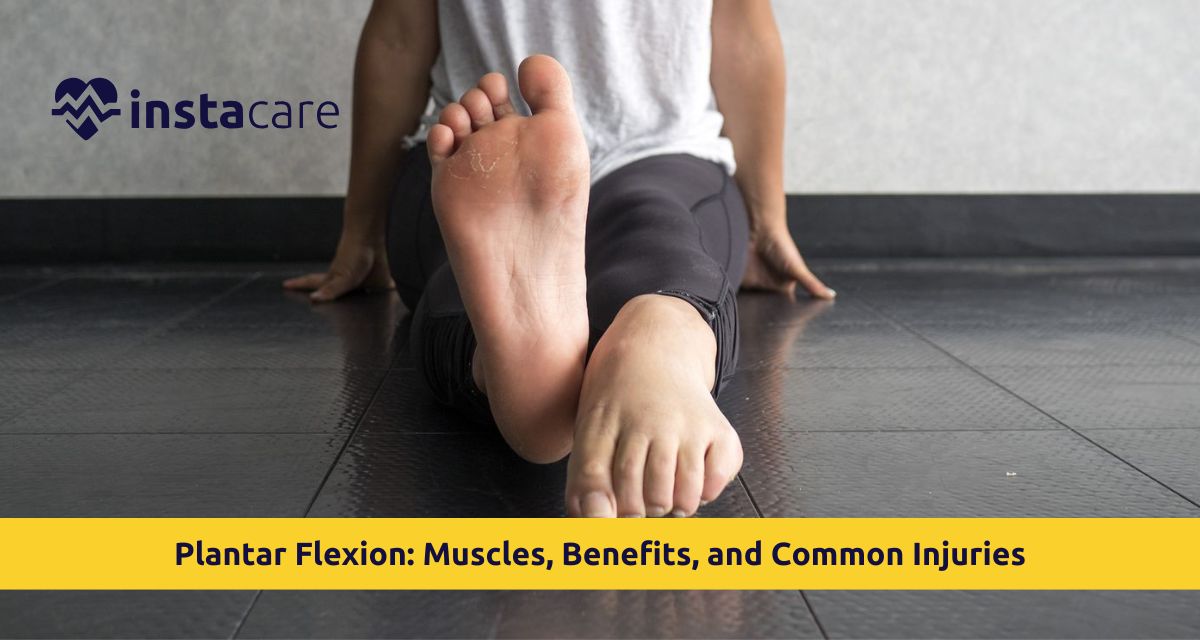Plantar flexion's the simple motion you do while moving, racing, or jumping. Getting how your ankle moves, what muscles fire up, or what might break down keeps your lower limbs working right.
What is Plantar Flexion?
Plantar flexion definition is when you point your foot downward, sending the toes away from the shin. Try pressing the gas pedal - your foot does that. Standing on tiptoes? Same motion. Dancers often snap their feet into this position fast. Walking uses it to push off the floor, while jumping or running needs it for power and momentum. These are just some examples of plantar flexion you see every day.
When plantar flexion points the toes downward, dorsiflexion does the opposite - pulling them up toward the shin. Because these actions oppose one another, they work together so the ankle plantar flexion can move without stiffness. Understanding dorsiflexion vs plantar flexion helps explain this mix that supports balance, helps you walk, or perform quick moves during physical activities.
The Anatomy Behind Plantar Flexion
Plantar flexion, just like dorsiflexion, needs multiple muscles to work together through tendons and joints simultaneously:
Plantar Flexion Muscles
Plantar flexion muscles mostly come from the gastrocnemius and soleus, the two muscles forming the calf. The gastrocnemius begins above the knee, doing most of its job when the leg is straight, whereas the soleus lies beneath and pushes hard whether the knee's bent or not. Several other muscles help out - such as the tibialis posterior, flexor hallucis longus, flexor digitorum longus, plus the peroneus longus and brevis.
Ankle Joint Structure
Motion takes place when the talus connects with the tibia and fibula, creating the talocrural joint. This hinge-like setup allows the foot to move downward across a plantar flexion range of motion of about 20 to 50 degrees. The extent varies based on factors such as body type, activity level, or tissue flexibility - no two people are alike.
Achilles Tendon
This strong band connects your calf muscles to the heel bone, delivering force whenever you push your toes down. Even though it's the body's most durable tendon, it endures intense strain during quick bursts of running or jumping. Understanding plantar flexion and dorsiflexion anatomy helps explain how these structures work together.
Common Functions and Movements
Plantar flexion function matters for daily motion, while popping up in sports too:
- On your tiptoes, moving ahead as you walk or dash
- Pressing the pedal down or slowing with your foot
- Pointing your toes in water
- Performing steps in dance
- Twisting mid-air during flips
- Even powering up into a jump, all rely on plantar flexion movement
Plantar Flexion in Walking and Running
Every time you move your legs to walk or sprint, the foot shifts down to push against the surface - this action shoves your body forward. As the step wraps up, the ankle's drop supplies the needed power to keep going. Plantar flexion in walking and running shows how fast runners rely on a sharp downward flick of the foot to boost speed while using less effort. With the heel lifting and the toes pressing hard, the joint angles down, pushing you ahead with each step.
Running, jumping in basketball or volleyball demands sharp bursts from your foot. People who drive their feet down harder tend to leap taller. Speed in this action typically ties to quicker sprints. Greater ankle motion backs up stronger leg force during intense motion. Small changes in how your foot tilts keep you from wobbling on uneven terrain or when you're up on just one leg - working alongside the lift of your foot to keep your body under control.
Common Issues and Injuries of Plantar Flexion
Some problems could affect your ability to move the foot downward:
Limited Plantar Flexion
Some folks struggle to press their foot downward - this limited plantar flexion could stem from past injuries, spending too much time in a cast, harm to the joint, or tension at the front of the ankle. If the foot doesn't glide right, it throws off your stride, complicates athletic moves, plus boosts injury risks.
Plantar Flexion Injury
Achilles tendinitis causes pain and swelling in the band connecting calf muscles to the heel, often from overuse or a fast increase in movement. Or maybe it flares up after a sudden burst of effort. A ruptured Achilles tendon is a severe type of plantar flexion injury needing quick treatment, typically occurring when someone jolts their foot downward hard. Calf strains involve damaged muscle fibers, ranging from mild to intense, leading to soreness when pressing the foot down. Rolled ankles mostly affect ligaments, but they can also limit motion due to tenderness and bloating.
Plantar fasciitis usually affects the sole, but pain near the heel can also limit how freely your ankle moves. Issues with nerves - like damage or conditions causing foot drop - can weaken the muscles needed to point the foot downward, throwing off your stride and motion.
Exercises to Improve Plantar Flexion
Ways to improve plantar flexion involve targeted strength exercises combined with flexibility drills:
Plantar Flexion Exercises
Go for heel raises to hit the key muscles - begin double-legged, later shift to single-leg for more challenge. Try seated calf lifts when you're aiming at the soleus harder. Grab a resistance band, press into it fully as you move to build strength. Strolling on your toes boosts power - while also improving balance and control.
Stretching and Flexibility Work
Swirl your ankle slowly to warm up the joint, helping your toes reach farther. Rather than using fingers, loop a cloth around your foot and gently tug to extend the front part of the ankle. Lean your sole into a wall to target the calf muscle, improving motion in the shin area with regular practice.
Functional Training
Jump rope sharpens foot push-off power while ramping up endurance. Beyond that, box jumps crank up explosive leg force. At the same time, stair climbing fires the calves nonstop, forging everyday lower-leg strength.
Progressive Overload
Begin by working with just your body's weight, later add resistance bands or light dumbbells - or switch to single-leg versions. Aim for 2 or 3 sessions weekly, spacing them out so you've got time to recover in between. These approaches show how to improve plantar flexion effectively.
Rehabilitation and Recovery Tips
Plantar flexion rehabilitation works to restore motion after injury:
Immediate Care
Start by chilling out, slap on some ice, wrap it snug - keep the foot up to ease swelling once you've twisted it. If it aches, leave it be; go for gentle motions every so often, just to keep things loose.
Progressive Strengthening
Once the pain eases, gradually reintroduce foot-pointing actions - start gently, increase reps. Experts often use static exercises at first, switching to dynamic ones as healing progresses. This staged approach is key to effective plantar flexion rehabilitation.
Flexibility and Mobility Work
Stretching keeps your foot moving smoothly as it heals. Start gently - tough stretches might delay healing. Slow movements work better, shielding sore spots while they build strength.
Return to Activity
Return to sports once you can flex your toes all the way without hurting, your power feels like the opposite side, yet you're moving through drills smoothly - no hobbling or odd stumbles.
Professional Guidance
When foot problems go bad, get advice from a pro - try a doc or
physiotherapist. These folks check the damage, map out recovery steps, then guide you toward safe movement again.
Injury Prevention
Warming up properly lowers the risk of getting hurt while moving hard. Ramping things up gradually gives your body time to adjust as you go. Giving muscles proper breaks between workouts helps them recover better. Footwear that actually fits reduces strain during action. Regular strength practice shields joints from wear and tear.
Conclusion
Plantar flexion helps you walk, play sports, or just move around daily. When you understand the muscles behind it - their shape, how they fire - you can catch problems faster and act wisely. If motion feels tight, you're recovering from injury, or you simply want better performance, tailored exercises paired with thoughtful rehab can restore and even improve this movement. Building flexible, tough calf muscles, combined with proper rest after strain, keeps your ankles healthy and your steps steady as time passes.
Please book an appointment with the
best Orthopedic Surgeon in Lahore, Karachi, Islamabad, and all major cities of Pakistan through
Instacare, or call our helpline at 03171777509 to find a verified doctor for your disease.

